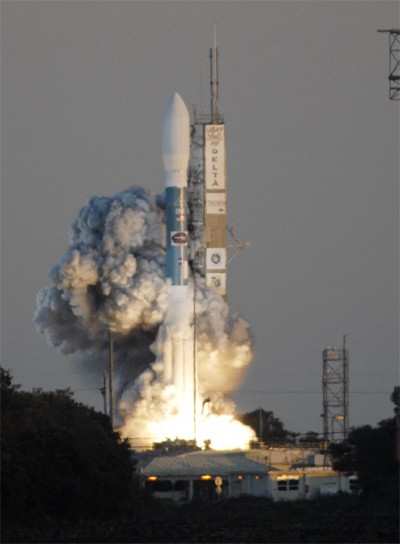Sun, Feb 18, 2007
Aurora Observation Project Underway
Five satellites... one rocket. Just past 6 pm EST Saturday,
NASA's THEMIS mission blasted off from Cape Canaveral Air Force
Station in Florida, racing into space on the flaming power of three
rocket stages and nine solid rocket motor.

Once in proper orbit, the five small satellites comprising the
Time History of Events and Macroscale Interactions during Substorms
(THEMIS) project will disperse around Earth to monitor auroras like
the Northern Lights.
NASA is undertaking the mission to investigate what causes
auroras in the Earth's atmosphere to change in appearance and
dissipate. Discovering why the light of auroras can fluctuate and
fade will provide scientists with important details on how the
planet's protective magnetosphere works and on the sun-Earth
connection.
As Aero-News reported, NASA
originally bumped the launch date to Friday, due to concerns at
Kennedy Space Center about an advancing cold front and the severe
storms accompanying it. The storms remained in the area throughout
Friday, causing stronger-than-acceptable upper-level winds and
resulting in a second 24-hour delay.
Named for the Greek goddess of justice, wisdom and good counsel,
and the guardian of oaths, THEMIS is a mission to investigate what
causes auroras in the Earth's atmosphere to dramatically change
from slowly shimmering waves of light to wildly shifting streaks of
color.
"The THEMIS mission will make a breakthrough in our
understanding of how Earth's magnetosphere stores and releases
energy from the sun and also will demonstrate the tremendous
potential that constellation missions have for space exploration,"
said Vassilis Angelopoulos, THEMIS principal investigator at the
University of California, Berkeley. "THEMIS' unique alignments also
will answer how the sun-Earth interaction is affected by Earth's
bow shock, and how 'killer electrons' at Earth's radiation belts
are accelerated."
NASA states discovering what causes auroras to change will
provide scientists with important details on how the planet's
magnetosphere works and the important Sun-Earth connection.
(Photo courtesy NASA)
More News
Pilot Also Reported That Due To A Fuel Leak, The Auxiliary Fuel Tanks Were Not Used On June 4, 2025, at 13:41 eastern daylight time, a Piper PA-23, N2109P, was substantially damage>[...]
Have A Story That NEEDS To Be Featured On Aero-News? Here’s How To Submit A Story To Our Team Some of the greatest new stories ANN has ever covered have been submitted by our>[...]
From 2023 (YouTube Edition): Reflections on War’s Collective Lessons and Cyclical Nature The exigencies of war ought be colorblind. Inane social-constructs the likes of racis>[...]
Aero Linx: Colorado Pilots Association (CPA) Colorado Pilots Association was incorporated as a Colorado Nonprofit Corporation in 1972. It is a statewide organization with over 700 >[...]
High Speed Taxiway A long radius taxiway designed and provided with lighting or marking to define the path of aircraft, traveling at high speed (up to 60 knots), from the runway ce>[...]
 NTSB Prelim: Piper PA-23
NTSB Prelim: Piper PA-23 ANN FAQ: Submit a News Story!
ANN FAQ: Submit a News Story! Classic Aero-TV: One Mans Vietnam
Classic Aero-TV: One Mans Vietnam ANN's Daily Aero-Linx (07.03.25)
ANN's Daily Aero-Linx (07.03.25) ANN's Daily Aero-Term (07.03.25): High Speed Taxiway
ANN's Daily Aero-Term (07.03.25): High Speed Taxiway



